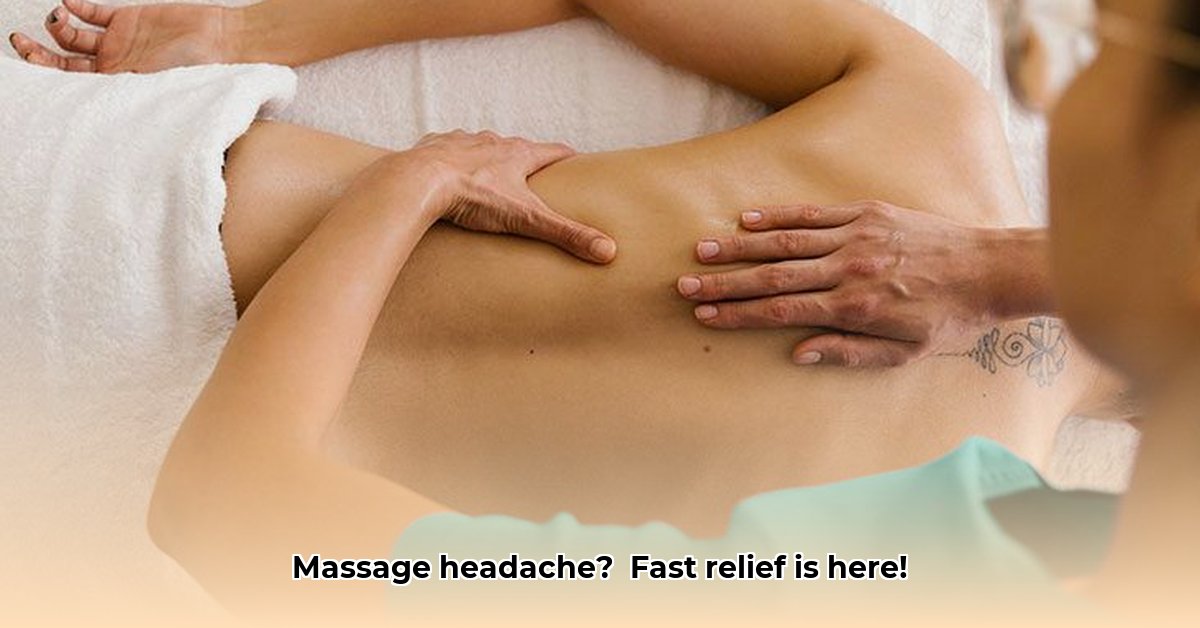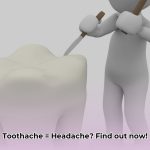Ever experienced a headache after a relaxing massage? It’s a common issue, and this guide will help you understand why it happens and how to find fast relief. We’ll explore the causes, prevention tips, and quick fixes to ensure your next massage is truly pain-free.
Understanding Post-Massage Headaches and How to Alleviate Pain
Have you ever experienced a headache following a massage? You’re not the only one. Studies suggest that up to 20% of individuals may experience a headache after a massage. Comprehending why they happen is the initial step toward avoiding them. This guide provides a complete overview to ensure your next therapeutic massage is centered around relaxation, not pain. Could dehydration be the primary cause, or are there other factors at play?
Why Do Post-Massage Headaches Occur? Exploring the Causes
A headache after a massage isn’t necessarily a sign of a problem; often, it’s a temporary discomfort. Understanding the potential causes can help you prevent future headaches and find relief quickly.
Here are some common reasons why headaches occur after a massage:
- Dehydration: If you are dehydrated, your body is more likely to develop headaches, especially when blood flow is boosted during massage. According to a study by G. Wardle et al., published in the Journal of Manipulative and Physiological Therapeutics, dehydration can intensify headache symptoms.
- Excessive Pressure: Deep tissue massage can trigger headaches in some people if the pressure used is too intense. Sore muscles and stiffness are common after a deep tissue massage.
- Muscle Tension Release: During a massage, muscle tension is released, promoting relaxation and alleviating pain. However, this release can lead to temporary discomfort and tension, which may manifest as a headache.
- Oil Sensitivities: Some individuals may have headaches or skin irritation due to sensitivities to massage oils, fragrances, or other skincare ingredients. Allergic reactions can also contribute to headaches.
- Blood Pressure Changes: Lying still for a long massage can cause postural hypotension, triggering a headache in some individuals; your body needs to adjust. Postural hypotension is a drop in blood pressure related to changing body position.
- Toxin Release: Massage therapy stimulates blood circulation and lymphatic drainage, facilitating the release of toxins from muscles and tissues. While this detoxification process is beneficial in the long run, the sudden release of toxins can sometimes lead to a temporary headache.
- Trigger Points: Trigger points, or hyperirritable areas within muscle fibers, can be activated during a massage, resulting in referred pain, including headache. Applying localized ice or heat, along with self-massage techniques, can help alleviate the pain associated with trigger points.
Effective Strategies for Headache Prevention After Massage
Avoiding post-massage headaches is possible by implementing a few simple steps. These strategies can significantly reduce your risk:
- Hydrate Adequately: Make sure you drink at least eight ounces of water before and after your massage; consider it pre- and post-workout hydration for your body’s systems. Increase your water intake for two days following a massage.
- Communicate with Your Therapist: Discuss your preferences, desired pressure levels, allergies, and previous experiences; they’re here to help you relax. Be very clear about the level of pressure you want.
- Begin Gently: If you are prone to headaches, opt for a gentle massage. You can always increase intensity after your sessions begin. Avoid deep tissue massages.
- Move Gently Afterwards: After your treatment, slowly sit up and stand to lessen the impact on your blood pressure.
- Select Oils Carefully: Request fragrance-free, hypoallergenic oils if you have sensitivities. Many therapists provide these choices. Avoid scented oils.
Quick Relief Tips for Post-Massage Headaches
Don’t fret if you develop a headache; try these simple ways to alleviate pain:
- Rest and Relax: Find relief in a quiet, dimly lit room that will help reduce stimulation and ease headache symptoms.
- Stay Hydrated: Drink plenty of water to combat dehydration that can worsen it.
- Over-the-Counter Relief: Medications like acetaminophen (Tylenol) or ibuprofen (Advil) can assist in reducing throbbing pain. Follow the recommended dosage.
- Apply Cold Compress: Comfort yourself by placing a cold compress over the forehead or temples to help manage head discomfort.
- Gentle Neck Stretches: Perform gentle neck stretches to release any tension or tightness that might be contributing to the headache. Slowly tilt your head forward, backward, and from side to side. Avoid any sudden or jerky movements.
- Avoid Stimulants: Steer clear of caffeine, alcohol, and other stimulants that can exacerbate headaches. Stick to hydrating fluids like water or herbal tea.
- Seek Professional Care: Persistent headaches will warrant a visit to a doctor.
When Should You Seek Medical Advice for Post-Massage Headaches?
Although most post-massage headaches are harmless, there are certain situations where you require professional medical assistance:
- Severe Head Pain: See a doctor right away if your headache is extremely painful combined with any unusual, severe symptoms such as nausea, vomiting, or changes in vision.
- Recurrent Headaches: Discuss these with your doctor if you often get headaches after massages. It’s crucial if you experience headaches following therapeutic sessions.
- Worsening Headaches: Get medical help if it worsens over time, regardless of whether you are using home remedies.
Remember, open communication is key to a positive massage experience. By discussing your preferences and any concerns with your massage therapist, you can work together to create a relaxing and headache-free session.
Proven Methods to Prevent Headaches After Deep Tissue Massage
Key Takeaways:
- Drink sufficient water before, during, and following your massage.
- Effectively communicate your needs with your massage therapist.
- Consider allergies and sensitivities to massage oils or environmental factors.
- Rise slowly after your massage to minimize blood pressure fluctuations.
- Investigate other massage methods if deep tissue causes consistent headaches.
Is a headache common for you after a massage? Although deep tissue massage has a large range of benefits, it can lead to post-massage headaches. Let’s look at ways to address the underlying problems! How can you ensure your deep tissue massage is beneficial and headache-free?
Identifying the Primary Causes of Post-Massage Headaches
Lots of things bring on post-massage headaches. Fluid deficits can contribute to post-massage headaches, as deep tissue massage boosts blood flow. Think of it like this, you need water to support blood circulation. Sensitivities and environmental factors matter as well. Sensitivities can cause headaches in some individuals, triggering allergic reactions or existing conditions like migraines. Muscle tension can cause headaches after massage as the body adapts to the new muscular changes.
A Step-by-Step Guide on How to Stop Headaches From Deep Tissue Massage
- Hydrate well: Increase your fluid consumption a few hours before your appointment. Make sure to aim for eight glasses of water and even more if in a warmer climate.
- Communicate: Open communication is crucial. Make sure to let them know about any sensitivities to scents or previous headaches.
- Moderate Pressure: Keep communication open during your session. If at any time the pressure feels painful, speak up right away.
- Gentle Movements Post-Massage: Limit postural hypotension risks by avoiding abrupt posture modifications following your massage.
- Massage Therapies: Evaluate aromatherapy massage, acupressure, or Swedish massage as better approaches to take to suit your relaxing needs.
Quick Tips for Relief
- Rest: Be sure to relax after your massage. Find a quiet, dimly lit room.
- Over-the-Counter Pain Relief: If headaches are a problem, acetaminophen or ibuprofen may resolve concerns regarding throbbing pain.
- Cold and Warm Compresses: Temporary pain can be relieved by placing a cold or warm compress on targeted areas.
- Avoid engaging in demanding activities directly after treatments.
The purpose of massage should revolve around well-being and relaxation. As you communicate with your therapist, you can reduce the possibilities of post-massage headaches.
Simple Steps to Prevent Post-Massage Headaches for Sensitive Individuals
Key Takeaways:
- Hydrate well before, after, and during massage sessions.
- Talk with your massage therapist to help with sensitivities.
- To better prevent risks of headaches, use gentle massage techniques.
- Manage symptoms after a session with cold compresses.
Comprehending the Issue
Is throbbing pain affecting your relaxing massage? It’s common. Up to 20% are affected by post-massage headaches. The increased flow of blood during massage, the use of essential oils, and dehydration are all possible causes. Here’s how to avoid them! Is this a common issue? Sinus headaches are a common allergic reaction.
Water Consumption
Fine-tune your body like a premium automobile. Improve the way your body functions with water. By increasing blood flow during massage, dehydration will occur. The solution? Hydrate with water today!
Pressure Pointers
Headaches can occur when there is increased pressure during deep tissue massage. If you feel awkward, notify your massage specialist. If the massage gets too painful, be sure to speak up.
Use of Essential Oils
Do you tend to have sensitivities to oils? Prioritize conversation to your therapist regarding headache prevention. Some unscented lotions have botanical ingredients that may cause sensitivity in some
- Achieve Anesthesiology Work-Life Balance: Your Guide - December 4, 2025
- Unlock Young Doctors’ Work-Life Balance: Actionable Strategies Now - December 2, 2025
- Unlock Life Harmony: Work-Life Integration Guide - November 30, 2025















